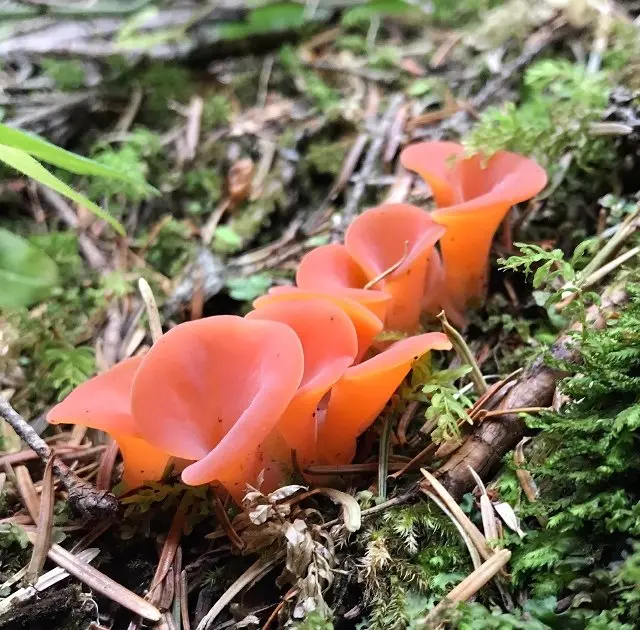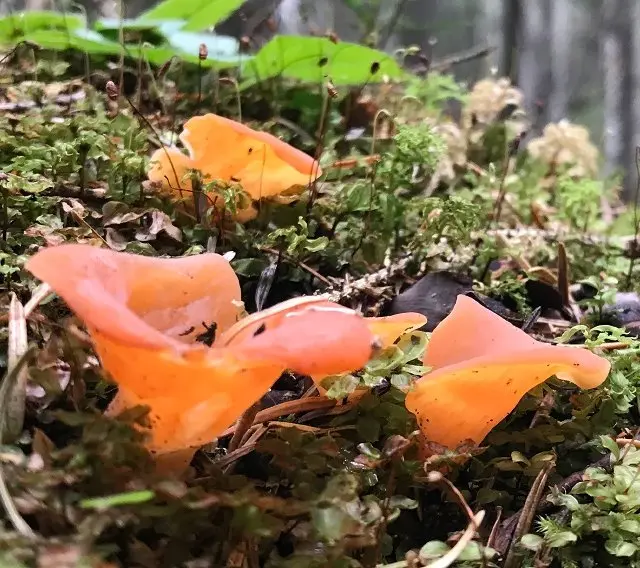Gepinia hevelloides (Guepinia helvelloides)
- Division: Basidiomycota (Basidiomycetes)
- Subdivision: Agaricomycotina (Agaricomycetes)
- Class: Agaricomycetes (Agaricomycetes)
- Subclass: Auriculariomycetidae
- Order: Auriculariales (Auriculariales)
- Семейство: Incertae sedis ()
- Genus: Guepinia (Gepinia)
- Type: Guepinia helvelloides (Gepinia gelvelloides)
:
- Guepinia gelvelloidea
- Tremella helvelloides
- Guepinia helvelloides
- Gyrocephalus helvelloides
- Phlogiotis helvelloides
- Tremella rufa

fruit bodies salmon-pink, yellowish-reddish, dark orange. By old age, they acquire a reddish-brown, brown color. They look translucent, reminiscent of confectionery jelly. The surface is smooth, wrinkled or veined with age, with a whitish matte coating on the outer, spore-bearing side.
The transition from the stem to the cap is almost imperceptible, the stem is conical in shape, and the cap expands upward.

dimensions mushroom 4-10 centimeters in height and up to 17 cm in width.
Form young specimens – tongue-shaped, then takes the form of a funnel or ear. On the one hand, there is definitely a split.

The edge of the “funnel” may be slightly wavy.

Pulp: gelatinous, jelly-like, elastic, retains its shape well, denser in the stem, cartilaginous, translucent, orange-red.
spore powder: white.
Smell: not expressed.
Taste: watery.

It grows from August to October, although there are mentions of finds of gepinia in the gelvelloidal spring and early summer. It develops on rotten coniferous wood covered with earth. Occurs in logging sites, forest edges. Prefers calcareous soils. It can grow both alone and in bunches, splices.
Widely distributed in the Northern Hemisphere, there are references to finds in South America.
An edible mushroom, according to taste, some sources classify it as category 4 mushrooms, it is used boiled, fried, for decoration in salads or simply in salads. Can be consumed without pre-treatment (raw). It is recommended to take only fairly young specimens, as the flesh becomes tough with age.
In addition to being used raw in salads, the mushroom can be marinated in vinegar and added to appetizer salads or served as a separate appetizer.
Apparently, the appetizing look, reminiscent of sweet jelly, prompted lovers of culinary delights to various experiments. Indeed, you can cook sweet dishes from gepinia: the mushroom goes well with sugar. You can make jam or candied fruits, serve with ice cream, whipped cream, decorate cakes and pastries.
There are references to using it to make wine by fermenting it with wine yeast.
Guepinia helvelloides is so different from other species that it is impossible to confuse it with any other fungus. Gelatinous hedgehog in texture is the same dense jelly, but the shape and color of the mushroom are completely different.
Some sources mention similarities with chanterelles – and indeed, some species (Cantharellus cinnabarinus) are outwardly similar, but only from a distance and in poor visibility. After all, chanterelles, unlike G. helvelloides, are completely ordinary mushrooms to the touch and they do not have a rubbery and gelatinous texture, and the spore-bearing side is folded, and not smooth, like a gepinia.









